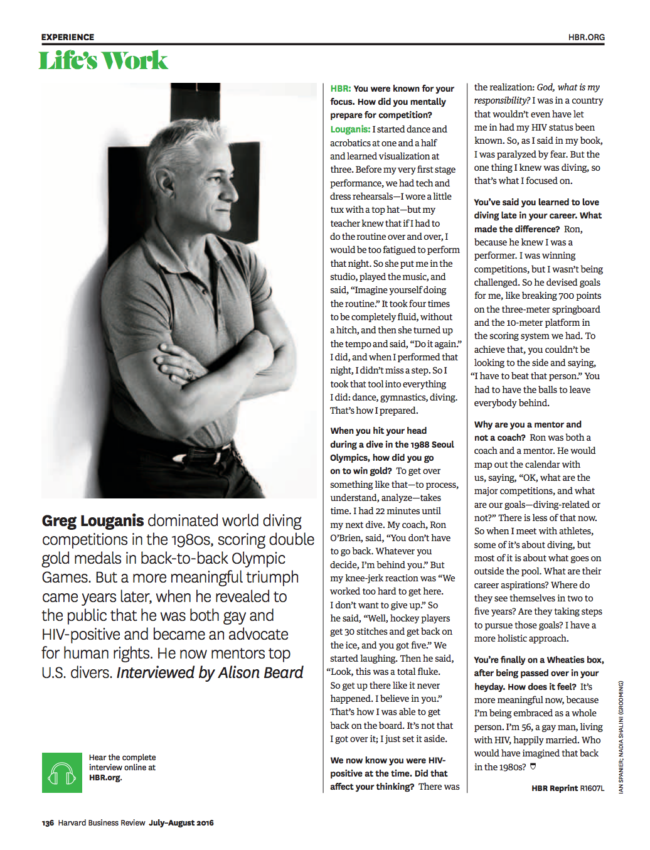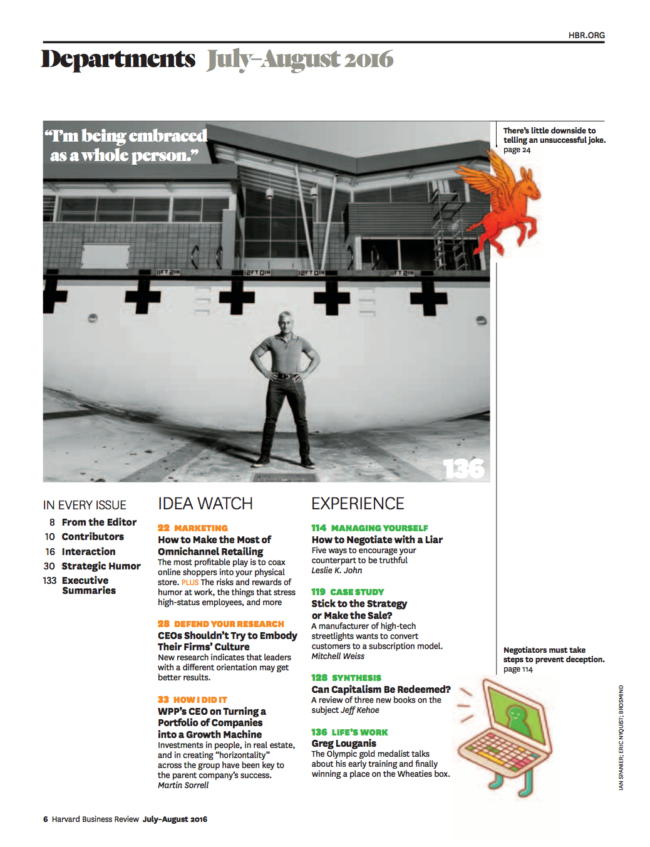

Harvard Business Review
Creative Director: Matthew Guemple
Art Director: Annie Chin
Photographer: Ian Spanier
Heidi: Where did you find the empty pool?
Ian: I was fortunate this pool in Hollywood was empty, and close to Greg’s home. Originally I tried to get access to an olympic pool, and was surprised it wasn’t so easy and the magazine was dead set on an empty one anyway.
Contextually there are many layers to this story, how did you approach that visually?
( this was about his decorated career as well as his activism )
I love stories that have a deeper level. I didn’t get to scout the pool, so I worked with what was there. I did research on what direction it faced and any other factors that would affect my shoot plan. The big plus signs were an added bonus, given the connection to HIV Positive, so I was lucky there, and to be honest the location as a whole was not great– the pool was dirty and with a small crew (me and one assistant) we couldn’t clean it up that much. B&W helped there as well. Greg was really nice, and I made a couple extra portraits of him for him. In return, he invited me to the screening of his latest short film called Saber Dance– where he plays Salvador Dali.
How did you get Greg to relax, become at ease?
Whenever I shoot celebrities or athletes there’s a bit of the unknown that doesn’t come into play when shooting non-celebrity subjects. I always ask my client how much time we will have, but assume time could be less (so if I only get two minutes, I am prepared to work within the limitation) If there’s more than one set-up I will have both ready to go, so I can quickly move my subject from set to set. I think this helps my subjects know that I am prepared, from there it’s less about the lights and camera and just gaining their trust. There is a lot of psychology behind photography. I like to review what the assignment is with the subject to make sure we are on the same page and usually I say something about me not being able to tell them how to just be themselves, but I am happy to suggest small changes from behind the camera. I do this just between us by having that conversation closely with my subject; no publicist, no assistants, and no crew hearing this part. I’ve found this to work well for me, particularly in quick situations. There’s a sense of trust that needs to be earned, often immediately. I like to think by putting them in charge out the gate, the subject either relaxes and does their thing, in essence appears as they want to, and I then choose when to press the shutter. If they are stiff, I take over. Ultimately, either scenario I am actually in charge. I like to think it’s almost like hypnosis, the moment I lull a subject into a place of comfort is generally the best part of the shoot. Sometimes I find the strobe firing over and over, or even the sound of the shutter does this, and other times I gain that trust by sharing an early frame when I know it looks good. Whichever gets things headed in the right direction.
How has your skills as a former photo editor come into play?
When I was a photo editor I would work directly with creative and art directors to formulate ideas for photo shoots, those years of experience really helped me the more I was on the other side of the shoot. I’ve always been an “ideas guy” so when I am given the chance to be part of the pre-shoot creative process or even make the call entirely at the shoot, I feel confident I can deliver. It’s great when a client comes to me with a distinct idea, as I have the opportunity to do their idea and time permitting any of my ideas, which only adds value to the project. When the art direction is unknown I feel pretty confident at this point that I’m being hired to come up with a solution. In the case of this shoot, the art director at HBR had presented the idea of shooting in an empty pool, and the section is always in B&W. I was also given the copy, which always help me know the mood the magazine wants. These are the best scenarios and are most like the scenario when I was on staff at magazines. Since the magazine is on the East Coast I would take the lead producing the shoot. I do work with producers (or my agent) for larger production shoots– but as a result of my past as a photo editor, when it comes to producing a shoot I can manage it just fine. Although it was not a factor in this shoot, one other aspect to my past is that I would always be in the position of having to manage the client’s budget. When shoots come with a smaller budget, it’s not ideal, but it’s a reality of a lot of shoots. I believe that it’s my job to make any size budget work– and at least visually appear as equally well produced as the big budget shoots.
Since you’ve been in the industry on both the hiring and shooting level, what has been the biggest impact you’ve seen in editorial shoots?
I think the biggest change today aside from shrinking budgets is the immense need for content. Digital is a big factor of this, as when we shot film there was almost always an end in sight. The decline of magazines and rise of social media is the other. Shots lists have climbed and the client’s need for assets for all the various outlets– far beyond the assignment alone are almost always a part of the shoot. I am often asked to shoot beyond any shot list, and even do both stills and video during the same shoot. This being the new reality, like everything else, it’s all about adaptation. Photographers have had to adapt to the rapid changes or be left behind.


